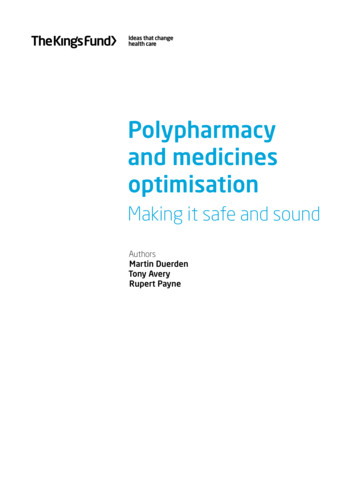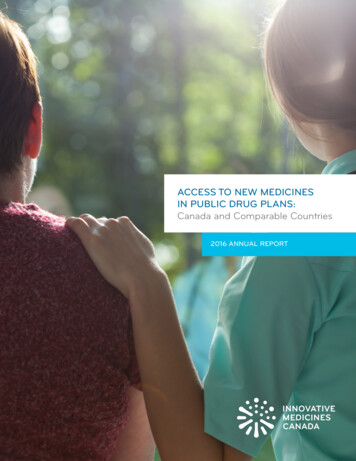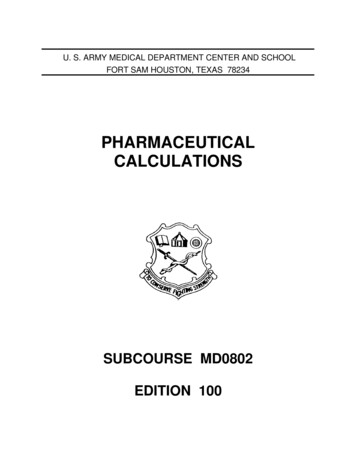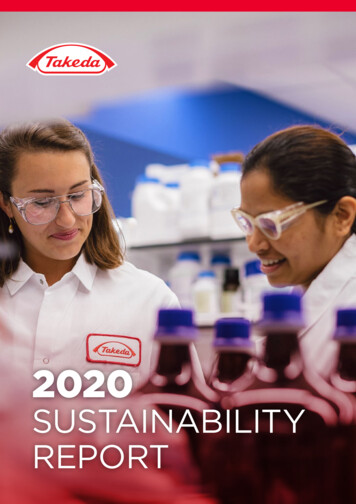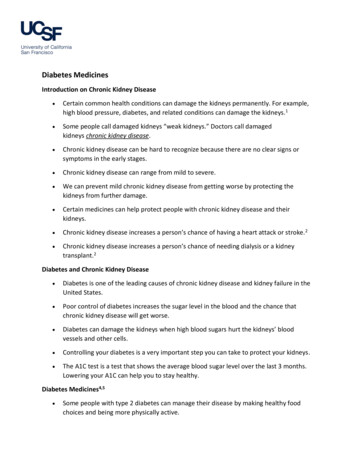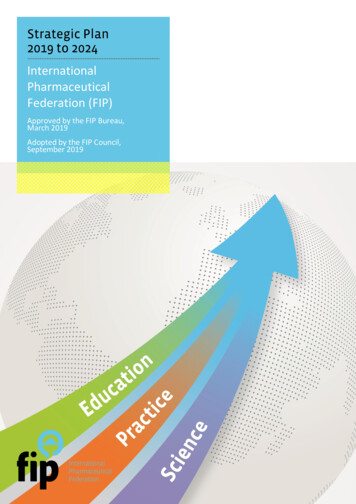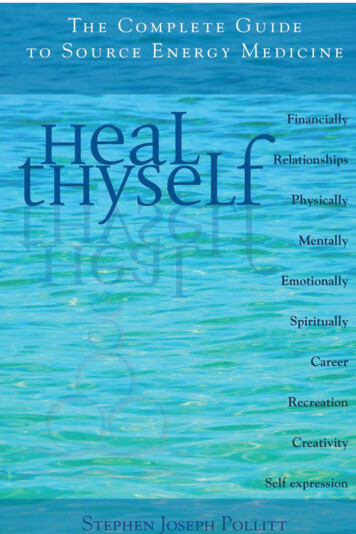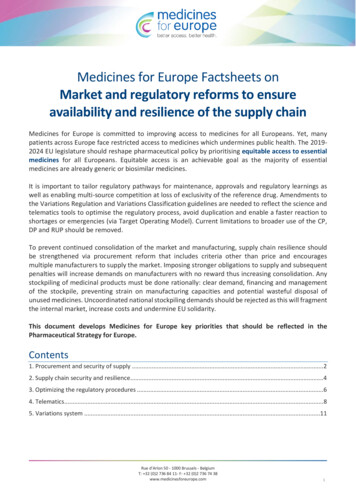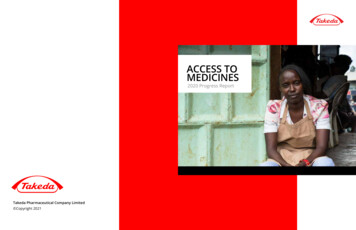
Transcription
ACCESS TOMEDICINES2020 Progress ReportTakeda Pharmaceutical Company Limited Copyright 2021
OVERVIEWTABLE OF CONTENTSPRESIDENT & CEO MESSAGE5ADVANCING HEALTH RESEARCH IN UNDERSERVED COMMUNITIESNever before has the attention of the world been more sharply focusedon health and its ability to impact every aspect of our lives.OUR JOURNEY SO FAROur industry-leading approach to building scientific capacity is helpingto advance sustainable health research and delivery systems. This isunlocking untapped potential in low- and middle-income countries (LMICs),while unleashing the power of Takeda employees.7PUBLIC POLICY & PATIENT ADVOCACYSince the launch of Takeda’s Access to Medicines (AtM) strategy in2016, we have strived to mobilize collective action to drive impactfor patients by strengthening local healthcare systems in a sustainableway. We are proud to share some of the highlights of our journey*.EVOLUTION OF OUR STRATEGY13BLUEPRINT FOR INNOVATIVE HEALTHCARE ACCESSSTRATEGY IN ACTIONACCESS TO HEALTH IMPACT FRAMEWORKAs the cornerstone of our Access to Medicines approach, Takeda’sPatient Assistance Programs (PAPs) are overcoming barriers faced bypatients in accessing innovative,patented medicines. The PAPs build onTakeda’s pricing philosophy and consider each patient’s personal andindividual circumstances.97Quantifying the outcomes of our Access to Medicines (AtM) programs isthe only way to determine its true impact. We look forward to using theAccess to Health Impact Framework across all our AtM programs andoffering it to the rest of the industry as a consistent way of measuringthe impact of access initiatives on patients and healthcare systems.2341ROADMAP FORTHE FUTUREAPPROACH17We are developing and accelerating ways to make our highly innovativemedicines available as quickly as possible by considering patient accessfrom start to finish of the medicines’ development process. At Takeda,we call this ‘end-to-end access.’INNOVATIVE ACCESS PROGRAMS81Takeda’s flagship Access to Medicines initiative is accelerating globalprogress in the prevention and treatment of Non-Communicable Diseases.Our intentis to strengthen and expand the Blueprint for InnovativeHealthcare Access across Sub-Saharan Africa and to the rest of the world.We have created a practical framework to guide and structure theexecution and evolution of Takeda’s Access to Medicines strategy,with an ambition of increasing patient access to innovative medicinesand elevating standards of healthcare for complex and rare diseases.END-TO-END ACCESS71We are collaborating with policy makers and patient organizations toaccelerate patient-centric healthcare provisions and ecosystems that fosterimproved access. This ranges from Universal Health Coverage (UHC) to ourinitiatives in capacity building, innovative access, and strategic partnerships.Watch Susanne Weissbäcker, Takeda’s Global Head of Access toMedicines, and Katie Dain, CEO, NCD Alliance, discuss the evolutionof Takeda’s Access to Medicines strategy, the lessons we’ve learned,and how we’ve used these insights to elevate our efforts and improveour programs.STRATEGIC FRAMEWORK55TOWARDS GLOBAL HEALTH EQUITY105There are clear yet complex links between sustainability, affordability,and patient access to care. At Takeda, we address these through ourglobal approach to Access to Medicines (AtM).VOICES OF ACCESS TO MEDICINESThe progress covered in this Report is the result of the collective effortsof our employees, partner organizations, and the frontline workers whowork tirelessly to save and extend the lives of patients around the world.We dedicate this Progress Report to them.109
PRESIDENT & CEO MESSAGE6Never before has the attention of the world been more sharply focused onAs you will see in this report, we have gained valuablehealth and its ability to impact every aspect of our lives. Overburdened healthcareexperience and made significant strides in our Accesssystems in developed and developing countries alike demonstrate the urgentto Medicines strategy since its launch in 2016, and evenneed to deliver appropriate COVID-19 therapies to those who need them most.since the inaugural Progress Report was publishedtwo years ago. And, while we are proud of what weWhile the pandemic is unparalleled in our lifetime in terms of intensity and impact,have achieved, we are determined to do more and arewe are no strangers to the themes of scientific innovation and access: nearly 2 billionenergized by the prospect of building and improvingpeople around the world have no access to basic medicines, resulting in suffering,partnerships, opportunities, and initiatives, all for thepoverty, and preventable death. Universal access to innovation isn’t unique tobenefit of patients.developing countries; it is an issue in highly developed countries too.Thank you for taking the time to read this Report.At Takeda, we strive every day to discover and deliver life-transforming treatmentsI trust that it will inspire you to share in my hope ofand vaccines that address unmet medical needs. But this is not enough for us. Wea better health for people, as well as a brighter andwant our innovations to have a purpose and improve the lives of people who needhealthier future for the world.them, no matter where they live or their ability to pay. That’s where our Access toMedicines strategy comes in.The strength of our Access to Medicines strategy lies in our end-to-end accessapproach, to make our highly innovative medicines available as soon as practicallypossible, and in our focus on innovation and initiatives that strengthen healthcareChristophe Webersystems at every stage of the patient journey. I consider Access to Medicines aPresident & CEO, Takedaresponsibility. It is also part of our business model.An example of an Access to Medicines program is our Blueprint for InnovativeHealthcare Access, a local community care program in Kenya and Rwanda focusedon Non-Communicable Diseases (NCDs). The Blueprint has been recognized as beingscalable and having an inclusive business model aimed to meet the access needs of apopulation at the very base of the economic pyramid.
8Our JourneySo FarSince the launch of Takeda’s Access to Medicines (AtM)strategy in 2016, we have strived to mobilize collectiveaction to drive impact for patients by strengthening localhealthcare systems in a sustainable way. We are proudto share some of the highlights of our journey*.
OUR JOURNEY SO FAR2016ACCESS TO MEDICINES TEAMand GOVERNANCEestablished102017ENHANCED PATIENTACCESS POLICY implementedNew POSITION ONINTELLECTUAL PROPERTYTakeda announces bold, newACCESS TO MEDICINES STRATEGYIndividualized approachto Patient AssistancePrograms designedAccess to Medicine 2016 Index:Takeda CLIMBS 5 PLACESfor Access to Medicines to expandaccess to our INNOVATIVEMEDICINES and VACCINES globallyAcquisition ofexpands Takeda’s portfolio to Rare Diseasesand Plasma-Derived TherapiesBLUEPRINT for Innovative HealthcareAccess begins pilot in Kenya to help strengthenhealthcare systems forNon-CommunicableDiseasesGLOBAL BLUEPRINT FOR SUCCESS eventconvenes over 150 GLOBAL EXPERTSto MOBILIZE collaborative actionAccess to Health Impact Framework starts toTakeda R&D initiates knowledge sharingcollaborations between employees,researchers, and scientists in LMICs**Structured donations and shared-valueprograms improve access to therapiesfor patients with rare andgenetic diseasesagainst Non-Communicable Diseases2018NOT-FOR-PROFIT approach inSUB-SAHARAN AFRICA launched2019Access to Medicine2018 Index:Takeda is the biggest climber,rising 10 positions to 5THFirst Takeda ACCESS TO MEDICINESPROGRESS REPORT chartsthe impact of our programs**Low- and Middle-Income Countries (LMICs), as defined by the World -groups. Accessed December 2020.measure impact of Takeda’s programson patient livesTakeda’s Access to Medicines efforts recognizedin Dow Jones Sustainability World Index2020Takeda hosts session atWORLD ECONOMICFORUM’S annualmeeting in Davos to addressUniversal Health Coverage in LMICs**Publication of Takeda’s1ST POSITION PAPERon Access to MedicinesSignificant strategic decision to transitionseveral countries in Takeda’s Growth &Emerging Markets Region, includingPhilippines, Vietnam, Egypt, South Africa,and in Sub-Saharan Africa, to a modelwhereby locally generated revenuesfrom our innovative medicines for complexand rare diseaseswill be reinvested inprograms that strengthen the localhealthcare system.
OUR JOURNEY SO FAR12Overview of AtM ProgramsLEBANONPAP – ADC, ENT, NINSOUTH AFRICAUKRAINEGeographies:PAPPAP – ADC, ENTHONG KONGPAPUAEAPAC & CHINA: Asia Pacific, ChinaPAP – ADC, ENTEGYPTPHILIPPINESTHAILANDICMEA & RUSSIA: India, CIS, the Middle East, Turkey, Africa, and RussiaPAP – ADCPAP – ADC, ENTPAP – ADC, ENT, NIN,Immunine, FEIBA, AlunbrigMALAYSIAPAP – ADC, ENT, NINSAM & BRAZIL: South Cone, Andean, Mexico & CAC(Central America and Caribbean), and BrazilINDIAMEXICOVIETNAMRUSSA &IASINGAPOREKENYAMeru County Blueprint forInnovative Healthcare AccessPAP – ADCUniversalHealthCoverage(UHC)AA& BRZILGLOVIETNAMR&D Clinical Trials& Early AccessProgramsBALZero BleedsApplicationInstrumentalAccess ProgramR&D Employee Fellowship ProgramDiabetes, GI &HyhpertensionChronic Care ProgramIntegrated Cancer Care forCurriculumPHILIPPINESHAITI / KENYA / TANZANIABlueprint for SuccessAmpath Oncology Preceptors& Telemedicine ProgramOncology Nursing EducationLSD PreceptorshipsPartnership withLast Mile HealthWorldFoundationof HemophiliaBRAZIL / COLOMBIAPathologistsEducationSeriesR&D EmployeeFellowship ProgramAfrican Consortium for CancerClinical Trials (AC3T)SUB-SAHARAN AFRICAPublic Health Foundationof IndiaAwarenessPAPPERUMax Access SolutionProgramSAMCHINC &APAPAP – ENTLSD CharitableAccess ProgramRare MOUwith MOHon RareDiseaseTreatmentGuidelinesICMEPAP – ADCPAP – ADCBRAZILPAP – ADCRareDiseasePolicyGLOBAL: All countries and regions in Takeda’s Growth & Emerging MarketsResearch & DevelopmentKENYAINDONESIAPartnership with Seed Global HealthMALAYSIADirect ReliefHCP trainingto expediteIBD diagnosisNCD AllianceMobile Access for Chronic CareOncology FellowshipPalliative Care TrainingChronic Care ProgramScreening & DiagnosisPrevention & TreatmentTANZANIASUB-SAHARAN AFRICA-AMREFRWANDAAmpathOncologyPreceptorships &TelemedicineProgramKAZAKHSTANLSD and HAEScreeningProgramsAFRICAADC, AdcetrisENT, EntyvioGHIT, Global Health Innovation TechnologyGI, GastrointestinalIDEEL, International Diabetes Educator E-Learning ProgramJOICFP, Japanese Organization for International Cooperation in Family PlanningLSD CAP, Lysosomal Storage Disorders Charitable Access ProgramNIN, NinlaroPAP, Patient Assistance ProgramPET/CT, Positron Emission Tomography/Computed TomographyPSP, Patient Support ProgramR&D, Research and DevelopmentUNICEF, United Nations Children’s FundCancer Educationfor PCPAmpathOncologyPreceptorships& TelemedicineProgramR&D ptorships &TelemedicineProgramUKRAINEPSP, CD30 Testing,PET/CTsEducation andDevelopmentPrograms forOncologist
14Evolution ofour StrategyWatch Susanne Weissbäcker, Takeda’s Global Headof Access to Medicines, and Katie Dain, CEO, NCDAlliance, discuss the evolution of Takeda’s Accessto Medicines strategy, the lessons we have learned,and how we used these insights to elevate ourefforts and improve our programs. (See next page.)
EVOLUTION OF OUR STRATEGY16As Takeda’s Global Headof Access to Medicines (AtM),Susanne leads the company’sAtM strategy and heads theAtM Office—a dedicated teamthat passionately drives thedevelopment and approvalof the strategy, monitorsimplementation, developsguidance for access-relatedobjectives, and buildsaccess competencies acrossthe company.Learn about Takeda’s partnership with the NCDAlliance to improve access and care for peopleliving with neglected and rare Non-CommunicableDiseases (NCDs).
18StrategicFrameworkWe have created a practical framework to guideand structure the execution and evolution of Takeda’sAccess to Medicines strategy, with an ambition ofincreasing patient access to innovative medicinesand elevating standards of healthcare for complexand rare diseases.
STRATEGIC FRAMEWORK20A MBI T I ONIncrease access to innovative medicines and elevate standardsof healthcare for complex and rare diseasesA PPR OA CHTHROUGHOUT THE PATIENT JOURNEY:Awareness & Prevention Screening Diagnosis Treatment Patient Care & SupportACROSS THE DRUG DEVELOPMENT PROCESS:Early Clinical Development Clinical Research Early Access Filing & Registration Post-Approval Intellectual PropertyIN FOCUSED THERAPEUTIC AREAS:Oncology Rare Diseases Vaccines Plasma-Derived Therapies Gastroenterology NeuroscienceT HE ME SInnovative AccessStandards of CareStrategic PartnershipsInnovative affordabilityAdvance the capacityCollaborate with policyprograms that transformof local health systemsmakers and advocacypatient access to innovative,to provide high-qualitygroups to acceleratepatented medicinespatient carepatient–centric provisionsST R A T E G Yand ecosystems
STRATEGIC FRAMEWORK22In low- and middle-income countries (LMICs), patients are facing challengesthat go beyond affordability barriers. The patient pathway in LMICs is complex,circuitous, and cyclical. It varies by healthcare system, disease area, and context,with multiple entry and exit points.In response, Takeda’s Access to Medicines (AtM) strategy is defined byinterventions that overcome hurdles and remove roadblocks faced by patientsat key touchpoints in their journey and, ultimately, improve health outcomes.Our Access to Medicines efforts contributetowards the United Nations SustainableDevelopment Goals (SDGs) for a betterand more sustainable future:Awareness & PreventionPromoting public awareness andeducation about prevention, screening,early detection, and treatment throughculturally appropriate campaigns thatalso address misconceptions andfalse information.ScreeningSupporting integrated massscreenings that break downdisease-specific silos, with timelydiagnostic follow-ups.PATIENT JOURNEYPatient Care & SupportEnabling continuous andappropriate support for patientsand caregivers, acknowledgingthat the patient journey evolvesthroughout their life.DiagnosisTraining community volunteers,primary care nurses andphysicians, and clinicalspecialists to increaseearlier diagnosis, acceleratereferrals, and deliverhigh-quality andconsistent localclinical care.TreatmentProviding innovative treatmentsand addressing affordabilitybarriers through early- andexpanded-access mechanisms,Patient Assistance Programs andstructured donations initiatives, andby working with other pharmaceuticalcompanies on treatment-financingmechanisms.
24End-to-EndAccessWe are developing and accelerating ways to makeour highly innovative medicines available as quicklyas possible, by considering patient access fromstart to finish of the medicines’ development process.At Takeda, we call this ‘end-to-end access.’
END-TO-END ACCESS26Takeda’s end-to-end accesscommitments include: Embedding access principles and plansfrom clinical development onwards Conducting multi-country clinical research Supporting early patient access Endeavoring to implement a globalfiling strategy Following pro-access intellectual propertyarrangements Addressing affordability challenges Ensuring uninterrupted, sufficient,and timely supply of products.
END-TO-END ACCESS28End-to-end access in actionAccess Principles and PlansAt Takeda, we start identifying patient access barriers and solutions when an assetis in clinical development. Through the use of holistic access plans, our productteams consider all aspects of access to medicines in individual drug developmentprograms, starting at research and development (R&D) and continuing as an assetprogresses through key milestones. Access planning is a key component in thedevelopment of our portfolio assets.A dedicated Center of Excellence (CoE) provides expert guidance on patient accessprinciples, policies, and governance to our R&D function and asset teams. The CoEalso oversees the implementation of our Early Access Programs which providepre-approval access to our investigational medicines.We are developing new vaccines to address some of the world’s most pressingpublic health needs, with a pipeline that focuses on diseases that are endemicto, or disproportionately affect, low- and middle-income countries (LMICs). Thisincludes neglected tropical diseases (NTDs) such as dengue and chikungunya1, Zika,and norovirus which, combined, infect approximately 1 billion people annually2.I was helpless.As a mother, I suffered,I asked my dad if I wasgoing to die,says Shermila, a mother of threechildren from Sri Lanka, all of whomwere infected with dengue.says Camila, a dengue survivorMeet her family and hear about thebroader impact of dengue.Watch her story and learn why theimpact of dengue goes well beyond theindividual patient.from Colombia.Scientists at Takeda are supporting external partner-led research by the GlobalWorld Health Organization. Neglected Tropical Diseases.https://www.who.int/neglected diseases/diseases/en/. Accessed November 20202Centers for Disease Control and Prevention. Norovirus breaks/worldwide.html;World Health Organization. Chikungunya Factsheet ail/chikungunya;World Health Organization. Dengue and severe dengue Factsheet ail/dengue-and-severe-dengue.All accessed November 2020.1Health Innovative Technology (GHIT) Fund, WIPO Re:Search, the National Institutesof Health, and the Global Health Repurposing Consortium, across a variety ofNTDs including chagas, leishmaniasis, onchocerciasis, and schistosomiasis, aswell as malaria and tuberculosis.
END-TO-END ACCESS30Clinical ResearchWe include participants from LMICs in clinical trials for our innovative medicinesand novel vaccine candidates, where we intend to register and where appropriate.Over 70,000 patients from 25 underservedcountries and communities have received accessto Takeda’s innovative medicines and vaccines, aswell as other supportive healthcare services throughTakeda-sponsored and -supported clinical trials.Our pivotal Phase 3 clinical trial for a dengue vaccine candidate is taking placein dengue-endemic areas in Latin America (Brazil, Colombia, Panama, DominicanRepublic, and Nicaragua) and Asia (Philippines, Thailand, and Sri Lanka).Our vaccine candidate for norovirus has completed a Phase 2bfield efficacy trial, and we are encouraged bythe results, whichwe consider a proof of concept for the vaccine. This data waspublished in Vaccine in September 2020.We have partnered with the National Minority Quality Forum, the HarvardMulti-Regional Clinical Trials program, and other organizations to enhance theparticipation of underrepresented populations and ethnic minorities in clinicalresearch and trials.In order to ensure continuity of care, we are committed to registering productsin countries where clinical trials have taken place.
END-TO-END ACCESS32Early Access ProgramsOur updated Global Patient Access Policy has established company-wideprinciples, governance, and procedures for providing safe, fair, and sustainablepatient access to Takeda investigational and marketed products at differentstages of their lifecycle.Our Early Access Programs ensure a variety of mechanisms that provideaccess to Takeda’s investigational medicines through: Post-Trial Access: patients enrolled in Takeda trials receive further accessafter the conclusion of trials if they meet program requirements, until thetreatment is approved in the respective country or becomes available throughanother trial or an expanded access program Expanded Access Programs: enables access for individual patients to adesignated medicine in cases where it is currently not yet licensed.This includes Individual Patient Requests and Named-Patient Programs.Filing StrategyWe endeavor to file for registration globallyin parallel to the first approval of a productin a major reference country. In doing so,we focus on LMICs with direct or indirectTakeda presence, high patient need, andsuitable health system infrastructures.We do not conduct clinical studies when weknow at the time the trial begins that wedo not intend to pursue registration andOur global filingstrategy wasrecognized asan industry bestpractice by theAccess to Medicine Foundation.(See page 91 of report.)commercialization in a particular country.We plan to begin regulatory filings for our dengue vaccine candidate in manycountries that are endemic for dengue infection, as well as the U.S. and Europe,in 2021. Subject to regulatory approval, we will work with governments, multilateraldevelopment banks and other partners to maximize the availability of, and accessto, the vaccine in the places of greatest need.
END-TO-END ACCESS34Intellectual PropertyWe follow pro-access Intellectual Property (IP)arrangements in least developed and low-incomecountries, where we will not file nor enforcepatents for Takeda’s marketed or future products.Learn more aboutTakeda’s Position onIntellectual Propertyfor Access to Medicines.Where possible, we support voluntary licenses and offer, under appropriate terms,licenses for low-cost access to our medicines on a selective basis.AffordabilityIn recognition that wealth and poverty levels vary across as well as withincountries, we have several approaches to addressing affordability barriersto access: Tiered pricing: adjust prices to a country’s socioeconomic status and thematurity of its health system Value-based agreements: respond to the needs of payers and providersto manage uncertainty around the real-world outcomes and economicimpact of our innovative medicines Patient Assistance Programs: increase access while addressingaffordability hurdles.I Googled it, then I cried,says Demie, from the Philippines, about her Hodgkin lymphoma diagnosis.Learn about the Takeda Patient Assistance Program and how it is helping patients like Demie on page 23.
END-TO-END ACCESS36Demand & SupplyWe take a global approach to demand and supply planning forall products to ensure uninterrupted, sufficient, and timely supply.As a member of the Pharmaceutical Supply Chain Initiative since2015, Takeda is committed to making sustainable improvementsin the supply chain and the Principles for Responsible SupplyChain Management.We have implemented a consistently high standard of Sales andOperations Planning across all markets to significantly uplift thestandards and supply chain capabilities in LMICs, which is part ofour efforts to build sustainable capacity at every stage.
END-TO-END ACCESS38Lifelong access to EnzymeReplacement Therapies forpatients with rare genetic diseasesI cannot explainhow [much] thismeans to me.Our structured donations program supports patients onAnd finally, I canElaprase, Replagal, and VPRIV, Enzyme Replacementlive a normal life.Therapies that are used to treat Hunter Syndrome,Fabry Disease, and Gaucher Disease, respectively.Patients are identified by an independent committeecomprised of physicians and a medical ethicist, and receivefree, lifetime therapy or until a more sustainable solution isin place locally. Close to 300 patients across 18 countrieshave benefitted from the program*.Meet Ivana and learn about her searchfor treatment which spanned three countriesand 10 years.The program is administered by the international NGODirect Relief and operates in select countries where Takeda’sproducts are not available; some patients have beendiagnosed; no local regulatory filing is planned or is morethan 12-24 months away; and in-country capabilities existto safely and effectively ensure patient access to treatments.The program also endeavours to support educationalactivities to confirm disease diagnosis and increaseunderstanding among the medical and patient communities.AlbaniaEgypt IndiaMalaysia BoliviaJordan MoroccoParaguaySudanBelarus BosniaKenyaPakistan South Africa Tanzania PalestineSouth KoreaTunisia* Cumulative number of patients from program inception until end 2020.
END-TO-END ACCESS40I’m very thankful to Takeda because I have the opportunityEarly access to Iclusigin partnership withThe Max Foundationto have access to treatment, but not only for me and thepatients from Paraguay, I’m also thankful that they helppeople all over the world. We have another chance now;we extend our life and we have more hope.Takeda’s Max Access Solutions programprovides early patient access to Iclusigfor the treatment of chronic myeloidRead Osbaldo’s journey of accessing treatment in Paraguay.leukemia and Philadelphia-positiveacutelymphoblastic leukemia. Theprogram is specifically designed tohelp uninsured or underinsured patientswhere the treatment is not availablecommercially, where significant accesshurdles exist, and where local marketinitiatives cannot enable access to thetherapy. The collaboration has supportedover 400 patients in 23 countries*.I felt as if my life was over[but] I got the treatment Ineeded and could recoverwell and have a new chanceat life.Hear Krishnan’s story of regainingprecious moments with his familyin India* Cumulative number of patients from program inception until end 2020.
42InnovativeAccessProgramsAs the cornerstone of our Access to Medicinesapproach, Takeda’s Patient Assistance Programs(PAPs) are overcoming barriers faced by patients inaccessing innovative, patented medicines. The PAPsbuild on Takeda’s pricing philosophy and considereach patient’s personal and individual circumstances.
INNOVATIVE ACCESS PROGRAMSI Googled it, then I cried.That’s how 21-year-old Demie describesher reaction to hearing she had Stage 3,Hodgkin lymphoma.44
INNOVATIVE ACCESS PROGRAMS46Demie’s father had stopped working after having a stroke the year before her diagnosis, and thefamily’s financial situation was dire. “I knew very well that she could not afford treatment. So, weenrolled her in the Takeda Patient Assistance Program,” says Francisco Lopez, Demie’s physicianand an oncologist, hematologist, and Head of Bone Marrow Transplant at St. Luke’s MedicalCentre in Manila, Philippines.Resource-poor countries with evolving healthcare systems often have inadequate private andpublic health insurance schemes, particularly when it comes to rare and complex diseases.Patients often bear the cost of medical treatment ‘out-of-pocket’ which can be financiallycatastrophic for them and their families.At Takeda, our pricing philosophy puts patients first. We aim to improve access to treatment forpatients who benefit from our medicines and work hard to ensure that price is not an obstacleto access to medicines for patients.As part of Takeda’s end-to-end access commitments, we address affordability challengesin three ways:1Tiered pricing allows for adjustments in price relative to a country’s economic stage andhealth system maturity to support as many patients as possible, gaining access to ourinnovative medicines worldwide.2Value-based pricing responds to payers’ and providers’ need to manage uncertainty around3Patient Assistance Programs (PAPs) support patients who have difficulty accessing medicines,the real-world clinical performance and economic impact of our innovative medicines.to obtain our innovative and lifesaving treatments. PAPs are a cornerstone of Takeda’s Accessto Medicines strategy to increase sustainable access to our medicines for complexand rare diseases, and build sustainable capacity across the patient journey,addressing accessibility barriers.Read Takeda’s Position on Pricing which defines our pricing philosophyand commitments.
INNOVATIVE ACCESS PROGRAMS48While tiered, inter-country pricing allows for adjustmentsrelative to a country’s economic stage and health system maturity,we recognize that affordability levels can vary considerably withina country, and from one person to another. Philip Towle, AccessTransformation Lead at Takeda, explains, “Improving patientaccess to innovative medicines for complex medical conditionsin low- and middle-income countries requires a highly personalizedand collaborative approach.” To address this, Takeda’s PAPsare increasing patient access to some of our most innovativetreatments. This includes patented medicines for Hodgkinlymphoma and large cell lymphoma, multiple myeloma,hemophilia, and inflammatory bowel disease.The majority of Takeda’s PAPs are based on individual levels ofaffordability (intra-country pricing) to help patients access theircomplete course of medication even if they cannot pay for it infull, at the intervals prescribed by their physician, in order togain the maximum medical benefit of the treatment.We have enlisted Axios International, an independent specialistin patient access solutions, to support the design and operationsof our PAPs. Each patient takes a confidential assessment thatdetermines how much financial help they need. The process usesa unique tool that considers individual income, assets, standard ofliving, and the national economic context.“The links between income, assets, and standard of living variesbetween, and within, countries,” says Joseph Saba, Chief ExecutiveOfficer of Axios. A physician and epidemiologist with a backgroundin statistics, Joseph worked with health economists to create thetool specifically for low- and middle-income country (LMIC) settings.“The tool used for a confidential assessment of patients is uniquebecause it looks at wealth indicators rather than poverty indicators.This more accurately reflects levels of individual affordability andcan help increase long-term access to innovative, patented drugsin LMICs.”
INNOVATIVE ACCESS PROGRAMS50Based on the results of the assessment, the patient sha
LSD CAP, Lysosomal Storage Disorders Charitable Access Program NIN, Ninlaro PAP, Patient Assistance Program PET/CT, Positron Emission Tomography/Computed Tomography PSP, Patient Support Program R&D, Research and Development UNICEF, United Nations Children's Fund Research & Development Awareness Screening & Diagnosis Prevention & Treatment
